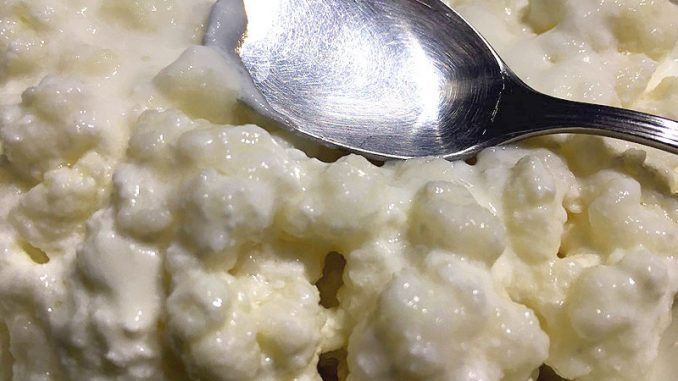
Once they start making milk Kefir, many of our readers realize that after a couple of brews their Kefir grains get covered by a semi-transparent mucous substance, they find “gooey”, “slimy”, and even “disgusting”. The questions we often get are “Should I get rid of this stuff?” or even “Is it dangerous?”
In some Kefir-dedicated forums and social groups, you can find opinions that “the slimy stuff” should be washed away and Kefir grains should be rinsed with water at every milk change “to get rid of that slimy substance covering them”.
Let me tell you something: that’s completely wrong!
So, let’s see what this substance really is, and is it dangerous in any way … or is it rather the opposite?
The “slimy stuff” called Kefiran
The mucous substance you’ll find covering your Kefir grains is called Kefiran. It is one of the most beneficial parts of the entire Kefir mix and is packed with virtues. It has powerful anti-microbial and anti-fungal effects and has been reported to have even antitumoral action.
Studies suggest that Kefiran significantly suppresses blood pressure, reduces cholesterol levels, reduces the negative outcomes of atherosclerosis, and can also lower blood glucose. Kefiran is also known to reduce inflammations and to increase the production of interferon which is an integral part of the anti-viral defenses of our bodies.
Kefiran is the living environment of Kefir grains and their active protective layer against pathogens in the environment.
The dominant microorganism in Kefiran is the bacteria called Lactobacillus kefiranofaciens and Kefiran itself is an Exopolysaccharide (EPS) – meaning a complex polymer sugar, also known as natural polymer, or biopolymer.
The most important benefit of Kefiran
As we said, Kefiran is a polysaccharide forming a protective layer (a biofilm) around the Kefir grains. The presence of Kefiran is a part of Kefir’s microorganisms lifecycle and a sign of healthy and constantly growing bacteria in the grains.
In other words, the existence of “that slimy stuff”, called Kefiran, is a clear indication that the grains are healthy, and it is by no means a sign of any problem.
But there’s an extra benefit of Kefiran: remember that it forms a protective biofilm that shields the Kefir grains, and this fact has more positive outcomes than you might think.
In the essence, Kefiran not only protects the bacteria of Kefir from external pathogens but also shields them from the harsh acids in our stomach.
As we know, the final destination of the probiotic bacteria of Kefir are the intestines, where they thrive, multiply and perform their beneficial activities.
However, to reach the intestines the bacteria of Kefir have to survive the extremely acidic environment in the stomach. Unfortunately, this is not easy and data show that only about 40% of Kefir’s bacteria succeed to survive the stomach acids and reach the intestines alive.
And here comes the extra benefit of Kefiran: it also protects the probiotic bacteria of Kefir from the stomach acids thus increasing their chance to successfully reach the intestines.
In other words, Kefiran may be regarded as a “Kefir improver”, boosting all beneficial probiotic effects of Kefir.
By the way, the same mechanism protects our stomach from its acids. The internal walls of the stomach are covered by mucus similar to Kefiran protecting the stomach from being deteriorated by its own acids. And when this mucus doesn’t act as expected, we get ulcers or other stomach diseases.
An additional benefit that Kefiran provides to Kefir grains is that its mucous character acts as an “antifreeze” preventing the grains from freezing if put into the freezer when they need to be stored for longer periods of inactivity.
What happens to Kefiran when ingested?
As a polysaccharide (polymer complex sugar), Kefiran cannot be directly metabolized, and that’s one of its assets. The shield that Kefiran provides to Kefir’s probiotic bacteria cannot be directly decomposed in the stomach. Its decomposition needs additional enzymes that are added later on in the digestive process.
So, after having completed its beneficial task to protect the probiotic bacteria and through the harsh stomach acids, under the effects of enzymes, Kefiran gracefully degrades into the monomers (or simple sugars) called glucose and galactose which then can be easily metabolized, providing our body with energy and nutrients.
Is it possible to reduce Kefiran in Kefir?
The bacteria in Kefir live in symbiosis but are also in constant competition with each other. Depending on a series of external factors such as the content of fats and minerals in the milk or the ambient temperature during fermentation, some bacteria or yeasts may prevail at the expense of others.
The yeasts in Kefir grains are responsible for converting milk lactose into polysaccharides, while the LAB (Lactic Acid Bacteria) are responsible for converting lactose into lactic acids. As a result, if the activity of yeasts is prevailing, the amounts of Kefiran will increase (remember: Kefiran is a polysaccharide). On the opposite, if the activity of Lactic Acid Bacteria prevails, the resulting Kefir will be more acidic and will contain less Kefiran.
Briefly, when the fermentation conditions favor the development of the yeasts, Kefiran will be more abundant, and when the bacteria’s activity gets favored, the Kefiran in resulting Kefir will be considerably less present.
It is believed that higher temperatures facilitate the activity of yeasts and may temporarily act in their favor. So, at earlier stages of fermentation, the activity of yeasts in Kefir may be prevailing and the quantity of Kefiran increased. Later on, however, the balance between yeasts and bacteria in Kefir is re-established and the quantity of Kefiran gets normalized.
On the other hand, lower temperatures (like when fermenting Kefir in the fridge) may inhibit the activity of the yeasts more than the activity of bacteria. As a result, Kefir that has fermented in the fridge may contain less Kefiran than the one fermented on the countertop.
But remember: Kefiran is one of the most beneficial parts of Kefir, and unless you definitely dislike its “look and feel”, your best option is to drink it along with your Kefir.
It is important to stress that, while Kefiran may look slimy on the Kefir grains, it is water-soluble and fully dissolves when mixed into the Kefir drink leaving no trace of any sliminess.
This gives an answer to the other question our readers often ask:
“Do we need to rinse the Kefir grains to get rid of that slimy stuff?”
The clear answer is no.
As the last resort, if Kefiran becomes too abundant and you really find it repulsive, you may rinse your Kefir grains with clean unchlorinated water once in every three or four milk changes. Remember though, that this will only force your Kefir grains to rebuild their protective layer of Kefiran, which will only be a waste of energy.
Prospective industrial applications of Kefiran
You will be probably surprised to learn that scientists are now developing a way to use Kefiran as a food packaging material that would not only have non-toxic, anti-microbial, and anti-fungal properties but also be … edible.
Additionally, the pharmaceutical industry sees in Kefiran a promising drug delivery material, that would not only be resistant to stomach acids but also fully bio-degradable, probiotic-rich, and with a vast range of nutritional and health-related virtues.
How is it possible? Well, remember that Kefiran is a polysaccharide or, in other words, a natural polymer, or biopolymer. Nowadays the food industry massively uses as packaging material synthetic polymers that are a real concern for the environment. Most of these polymers (plastics) are not only non-bio-degradable but are often toxic.
In recent years, lots of scientists put a lot of effort into developing fully renewable packaging materials that would substitute the traditional synthetic polymers (plastic) packaging. While some of these efforts appear to be successful with the appearance of new bio-degradable packaging materials based on cellulose, starch, or soy protein, it appears that Kefiran offers much more promising characteristics.
Kefiran not only has excellent strength characteristics comparable with most traditional packaging materials but also offers a long list of other benefits like being anti-microbial, anti-fungal, fully biodegradable, healthy, and even edible.
Summary
The “slimy” or “gooey” substance that covers Kefir grains and some people find “disgusting” is called Kefiran and is one of the most valuable parts of Kefir.
Kefiran is a complex sugar (polysaccharide) and not only provides a “natural habitat” to Kefir’s bacteria and yeasts but also ensures their protective layer against external pathogens.
Beyond its many health-related benefits with directly suppressing blood pressure, reducing cholesterol levels, limiting the consequences of atherosclerosis, as well as lowering blood glucose, Kefiran also provides a protective shield to Kefir’s bacteria allowing them to survive the harsh acidic environment in the stomach.
Kefiran is mainly formed by a bacteria called Lactobacillus kefiranofaciens and its presence in Kefir is a sign of thriving and healthy Kefir grains.
Briefly, Kefiran may be regarded as an agent amplifying the beneficial properties of Kefir.
Related questions
-
Should I rinse the Kefir grains at each milk change to get rid of that “slimy stuff”?
The short answer is no! Kefiran is one of the most beneficial parts of Kefir, and unless you definitely dislike its “look and feel”, your best option of to drink it along with your Kefir. As the last resort, if Kefiran becomes too abundant, you may rinse your Kefir grains with unchlorinated water once in every three or four milk changes. Additionally, while at first glance Kefiran may look slimy, it is water-soluble and dissolves fully when mixed into the Kefir leaving no trace of any sliminess.



